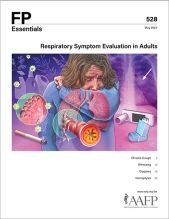
This clinical content conforms to AAFP criteria for CME.
Wheezing is a common presenting concern in the primary care setting, but its etiology can be elusive. Wheezing is associated with many disease processes, but most commonly, asthma and chronic obstructive pulmonary disease. Initial tests for wheezing typically include a chest x-ray and pulmonary function testing with bronchodilator challenge. Advanced imaging to evaluate for malignancy should be considered in patients older than 40 years with a significant history of tobacco use and new-onset wheezing. A trial of short-acting beta agonists can be considered while awaiting formal evaluation. Because wheezing is associated with reduced quality of life and increased health care costs, it is essential to develop a standardized evaluation of this common concern and expeditiously manage symptoms.
Case 2. AP is a 42-year-old patient who comes to your office because of intermittent wheezing for the past 3 months. Symptoms began after an episode of viral bronchitis. She has not had any other residual symptoms. AP had asthma as a child, but it resolved during early adolescence. She is otherwise healthy, takes no drugs, does not smoke, and exercises regularly. The results of an office spirometry show a forced expiratory volume in the first second of expiration/forced vital capacity (FEV1/FVC) ratio of 0.67. The FEV1 is 75% of the predicted normal value, and the FVC is normal. AP wonders if her asthma has returned.
Definition and Pathophysiology
Subscribe
From $350- Immediate, unlimited access to FP Essentials content
- 60 CME credits/year
- AAFP app access
- Print delivery available
Edition Access
$44- Immediate, unlimited access to this edition's content
- 5 CME credits
- AAFP app access
- Print delivery available
